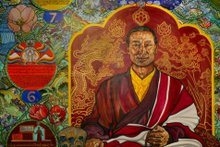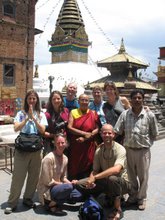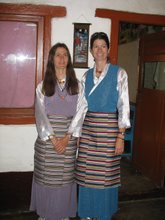My name is Jane Lillian Vance.
On behalf of my film team, let me express our thanks to the University of Virginia, in particular to Pat Lampkin, who reached out to us while we were still in Kathmandu this past summer.
Pat; Dan, Gil, and Alex; my film team; my own two children Iris and Emerson who are both here at UVa, David; and assembled guests: thank you all for being here today.
I am here, because of my fortune to have been Morgan Harrington's teacher.
I taught Morgan a course offered through Virginia Tech's Department of Religion and Culture, called The Creative Process.
In my course, I suggest to my students that love and loss are the two tributaries of the creative impulse--that cherishing causes the sensual hieroglyphics of generosity, and that grieving causes the agonized braille of memorial.
Morgan, who was expressive, conceptual, artistic--brilliant--sat with perfect front-row posture before these ideas.
Allow me to share with you a little about this young woman, who is being honored today, from when she was my student.
In The Creative Process, after reading Gita Mehta's A River Sutra, Morgan wrote about the psychological clash of old village India and cyberspace. She concluded that, especially if you view your life as a pilgrimage, it is poisonous to repudiate your past. She loved, instead, Walt Whitman's idea of synthesis: Do I contradict myself? Very well then, I contradict myself. I am large--I contain multitudes.
Morgan collaged for me about the national bruise inflicted by Hurricane Katrina and about New Orleans' brave, creative community responses to its unprecedented damage. She relished Truman Capote's vignettes in Music for Chameleons, and loved Capote's designation of fireworks--and conversation--as his favorite art forms. She sparked when I said there doesn't need to be much difference between the two.
In my course, Morgan read a book called The Voice That Remembers, written by a Tibetan woman who endured nearly three decades of degradation and torture in labor camps. Morgan learned why His Holiness the Dalai Lama believes that Tibetan Buddhism is so relevant to the West, as a spiritual technology, not a religion; a technology of mind, compatible with any faith, or any culture.
Morgan designed a Tibetan-style shrine to enfold her own core values and nascent aspirations. Allow me to quote from Morgan's accompanying essay: she wrote--
"One of the central objects of my shrine is a huge, comfy chair that my Dad sits in every night to finish his work from the office. All throughout my youth I would jump up on his lap to share this chair, and nudge his pile of never-ending work aside with grass-stained toes. He would never shove me off and continue work, as some adults might have done. Instead, he always took the extra minutes to cuddle, and show that he loved me, despite all of his expectations at work.
" I balanced an incense burner near the bottom of my shrine to symbolize spirituality and larger than life ideals that I struggle to accept. My maternal grandparents helped shape who I am because they raised the most important person in my life, my mother--a lock of her strawberry blonde hair is nestled into the deep center of my [imagined] shrine as the relic because I love
her so much and strive to be more like her. I look to my mom as a spiritual example because she is so open-minded. She is a very spiritual person and I see how this trust enriches her life, so I plan to spend more time exploring higher powers and positive energies instead of focusing on things that are insignificant in comparison. It is easy to get in a monotonous routine and
forget about the changes that I need to make in my life. With these objects places on my shrine, I have a higher likelihood of succeeding in these changes because the reminders will be ever-present."
As it happens, Morgan appears, breifly, three times in the film you are about to see. We did not edit her in. She was simply there, in our story, standing right beside Amchi Tsampa, the subject of our film when he visited our Virginia Tech Creative Process class during my semester with Morgan. And again, there was Morgan, at my home, with her classmates, as Jenna Swann filmed. You will see Morgan there for a moment, on my living room floor. She is the student who
is smiling.
Morgan would have traveled with my film team and me this past summer for the world premiere of our film in Nepal. She wanted to go trek to meet the people with the fierce and gentle spiritual technology we studied. She told me that she wanted this experience because she was going to become a teacher.
I hope you enjoy our documentary. Morgan saw parts of it in early drafts. Our co-producers Jenna Swann and Tom Landon have edited for years to bring you this story.
And now it is my privilege to present our narrator, Lisa Mullins, whose incredible voice most of you know from her brilliant Public Radio International work. Lisa, will you please do us the honor of presenting A Gift for the Village, which is dedicated--from my heart--to my front-row girl, my teacher, Morgan Harrington.
Thursday, October 21, 2010
Subscribe to:
Posts (Atom)















